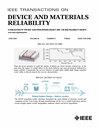阻焊层差异对商用插接电路电气响应的影响
IF 2.5
3区 工程技术
Q2 ENGINEERING, ELECTRICAL & ELECTRONIC
IEEE Transactions on Device and Materials Reliability
Pub Date : 2024-04-01
DOI:10.1109/TDMR.2024.3384065
引用次数: 0
摘要
印刷电路板(PCB)等电子基板在现代技术中的应用几乎无处不在。随着印刷电路板变得更小、更密集和大规模生产,越来越多的印刷电路板插接(IDC)传感器被用来验证制造电子组件的几何、材料和工艺决策。尽管如此,在确定这些应用中印刷电路设计的可重复性和可靠性方面的准确性还没有得到很好的研究。在本文中,我们报告了使用小信号交流阻抗光谱来确定测量可重复性和单个 IDC 设计的制造电路板可重复性与频率、湿度和焊接掩模覆盖率的函数关系。通过这些测量,可以检测到频率(10MHz-0.1Hz)和湿度(96%-10%RH)变化时电气响应的系统性变化。我们的交流阻抗测量结果表明,测量的重复性误差优于 0.6%,而电路或电路板的再现性则在 2.5%-5.2% 之间。对电路结构进行的详细表面分析表明,观察到的差异主要是由于阻焊层的多孔性以及阻焊梳之间的焊料涂层厚度和覆盖率的差异造成的。结果可以用一个模型来解释,该模型考虑了水的表面吸附,然后渗入孔隙,最后随着环境湿度的增加通过阻焊层扩散。使用虚电模量 M "与对数频率图最容易检测到这些影响。预计这种方法可应用于其他电路设计、阻焊层或污染变化。本文章由计算机程序翻译,如有差异,请以英文原文为准。
Effects of Solder Mask Variability on the Electrical Response of Commercially Manufactured Interdigitated Circuits
The use of electronics substrates, such as printed circuit boards (PCBs) in modern technology has become nearly ubiquitous. As PCBs become smaller, denser and mass produced, printed, interdigitated circuit (IDC) sensors are increasingly utilized to qualify the geometric, material and process decisions for manufacturing electronics assemblies. Despite this, the accuracy in determining reproducibility and reliability of printed circuit designs for these applications is not well studied. In this article we report on the usage of small signal ac impedance spectroscopy to determine measurement repeatability and manufactured board reproducibility as a function of frequency, humidity and solder mask coverage for a single IDC design. These measurements allowed detection of systematic changes in the electrical response as the frequency (10MHz-0.1Hz) and humidity were varied (96%-10%RH). Our ac impedance results indicate that the measurement repeatability error is better than 0.6% while circuit or board reproducibility ranges from 2.5%-5.2%. Detailed surface analysis of the circuit structures indicated that differences observed were primarily due to porosity in the solder mask as well as differences in solder coating thickness and coverage between the interdigitated combs. Results are explained by a model that considers water surface adsorption, then infusion into the pore space and finally diffusion through the solder mask as the humidity of the ambient increased. These effects were most easily detected using imaginary electric modulus M” vs log frequency plots. It is anticipated that this methodology will have application to other circuit designs, solder mask or contamination variability.
求助全文
通过发布文献求助,成功后即可免费获取论文全文。
去求助
来源期刊

IEEE Transactions on Device and Materials Reliability
工程技术-工程:电子与电气
CiteScore
4.80
自引率
5.00%
发文量
71
审稿时长
6-12 weeks
期刊介绍:
The scope of the publication includes, but is not limited to Reliability of: Devices, Materials, Processes, Interfaces, Integrated Microsystems (including MEMS & Sensors), Transistors, Technology (CMOS, BiCMOS, etc.), Integrated Circuits (IC, SSI, MSI, LSI, ULSI, ELSI, etc.), Thin Film Transistor Applications. The measurement and understanding of the reliability of such entities at each phase, from the concept stage through research and development and into manufacturing scale-up, provides the overall database on the reliability of the devices, materials, processes, package and other necessities for the successful introduction of a product to market. This reliability database is the foundation for a quality product, which meets customer expectation. A product so developed has high reliability. High quality will be achieved because product weaknesses will have been found (root cause analysis) and designed out of the final product. This process of ever increasing reliability and quality will result in a superior product. In the end, reliability and quality are not one thing; but in a sense everything, which can be or has to be done to guarantee that the product successfully performs in the field under customer conditions. Our goal is to capture these advances. An additional objective is to focus cross fertilized communication in the state of the art of reliability of electronic materials and devices and provide fundamental understanding of basic phenomena that affect reliability. In addition, the publication is a forum for interdisciplinary studies on reliability. An overall goal is to provide leading edge/state of the art information, which is critically relevant to the creation of reliable products.
 求助内容:
求助内容: 应助结果提醒方式:
应助结果提醒方式:


